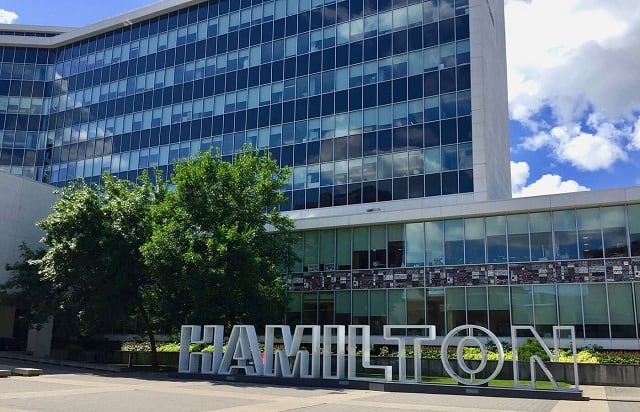Hamilton developer ordered to pay city’s legal costs after failed lawsuit
Published October 28, 2021 at 8:45 pm

A local developer who tried suing the City of Hamilton for $33 million has now been ordered to pay their legal bill of over $20,000.
The decision might also put a wrap on the saga of the West Harbour stadium that never was.
In a ruling issued last week, the Ontario Land Tribunal (OLT) said the White Star Group of Companies and its principal, Marino Rakovac, must pay the city’s costs of responding to White Star’s damages suit that was filed earlier this year. Richard Makuch, the vice-chair of the OLT, affirmed that White Star “engaged in a repeated and deliberate pattern of unreasonable, vexatious, and bad faith conduct over an extended period of time in this case.”
That included, “repeated attacks on the City’s counsel … making allegations without any basis whatsoever of coaching witnesses, suppressing evidence, intimidating City staff, and threatening or harassing opposing counsel, as well as threatening to report the City’s legal counsel to the Law Society of Ontario for professional misconduct solely as part of an attempt to gain leverage in this matter.”
Officially, White Star and Rakovac, whom the OLT called the “true litigant” in the damages suit, has to pay the city $21,310.65 plus HST.
That is $24,081.03 with the sales tax. The decision can be appealed in civil court.
Quarter-century battle
The bone that White Star had to pick with the city involves a property around Bay Street North, Stuart Street and Tiffany Street, near the current West Harbour GO Station.
It was an auto wrecking yard when Rakovac purchased it in 1995. The long-term goal, according to media reports, was to have it re-zoned in order to build condominiums. That happens to be the type of medium-density housing that Hamilton is often said to lack.
There was still an auto-wrecking yard there until around 2005. That came during a period when the city was considering building a stadium to replace Ivor Wynne Stadium. It would host a multisport event such as the Commonwealth Games and Pan Am Games, which Canada’s summer-sport athletes compete in every four years, and become the new home of the Hamilton Tiger-Cats.
Another complicating matter with getting rezoning applications approved was that CN Rail has large operations near the West Harbour. The rail giant had an interest in opposing or limiting development.
In the late aughts, the city began to kick the tires, as it were, on expropriating White Star’s in order to build a stadium. The setting would have been central for sports fans and by a proposed GO Station.
It might also proven conducive to outdoor concerts. Ivor Wynne, which is in a residential neighbourhood and was essentially banned from hosting concerts for decades after the infamous Pink Floyd show in 1975.
The city never formally filed to expropriate White Star’s land. The Tiger-Cats balked to move to the West Harbour. Ultimately, the city decided in 2011 to raze Ivor Wynne, the fabled ‘madhouse on Melrose,’ and build Tim Hortons Field on the same site.
The West Harbour GO Station and Tim Hortons Field both opened in 2015. Because CN had priority over the railway tracks, the GO Station was underused until Metrolinx added all-day service to Hamilton earlier this year. Hamilton will host its first Grey Cup game at the new stadium in December.
Meantime, White Star and Rakovac still had a property that they claimed could not be developed, because of what they saw as uncertainty created by the Cty of Hamilton.
That led White Star and Rakovac to eventually file the $33-million damages suit. It was dismissed by the Land Planning Appeal Tribunal in April.
In his subsequent ruling, the OLT’s Makuch detailed some of the objectionable conduct by White Star and Rakovac during the doomed damages suit:
- “Flagrant violation” of civil procedure by holding examinations of current Ward 14 City Councillor Terry Whitehead and former Hamilton mayor Larry Di Ianni in secret, without telling the other side’s counsel. Basic rules of discovery allow for both sides’ counsels to interview witnesses.
Both Di Ianni and Whitehead had tried to mediate the dispute in 2011.
- Threatening to complain to the Law Society of Ontario if a “settlement or adjournment” was not reached, and accusing the city’s lawyer of “coaching witnesses” and “suppressing evidence.”
- That the developer “was simply attempting to relitigate the entirety of the history of the matter instead of dealing with the substance of the actual Motion before the (LPAT).”
- Taking “vexatious and inappropriate” actions that forced the city’s counsel to “file unnecessary motion materials.”
The cost order of just more than $24,000 is the maximum that the OLT can issue against an unsuccessful litigant.
The full ruling is available at canlii.org.
insauga's Editorial Standards and Policies advertising





